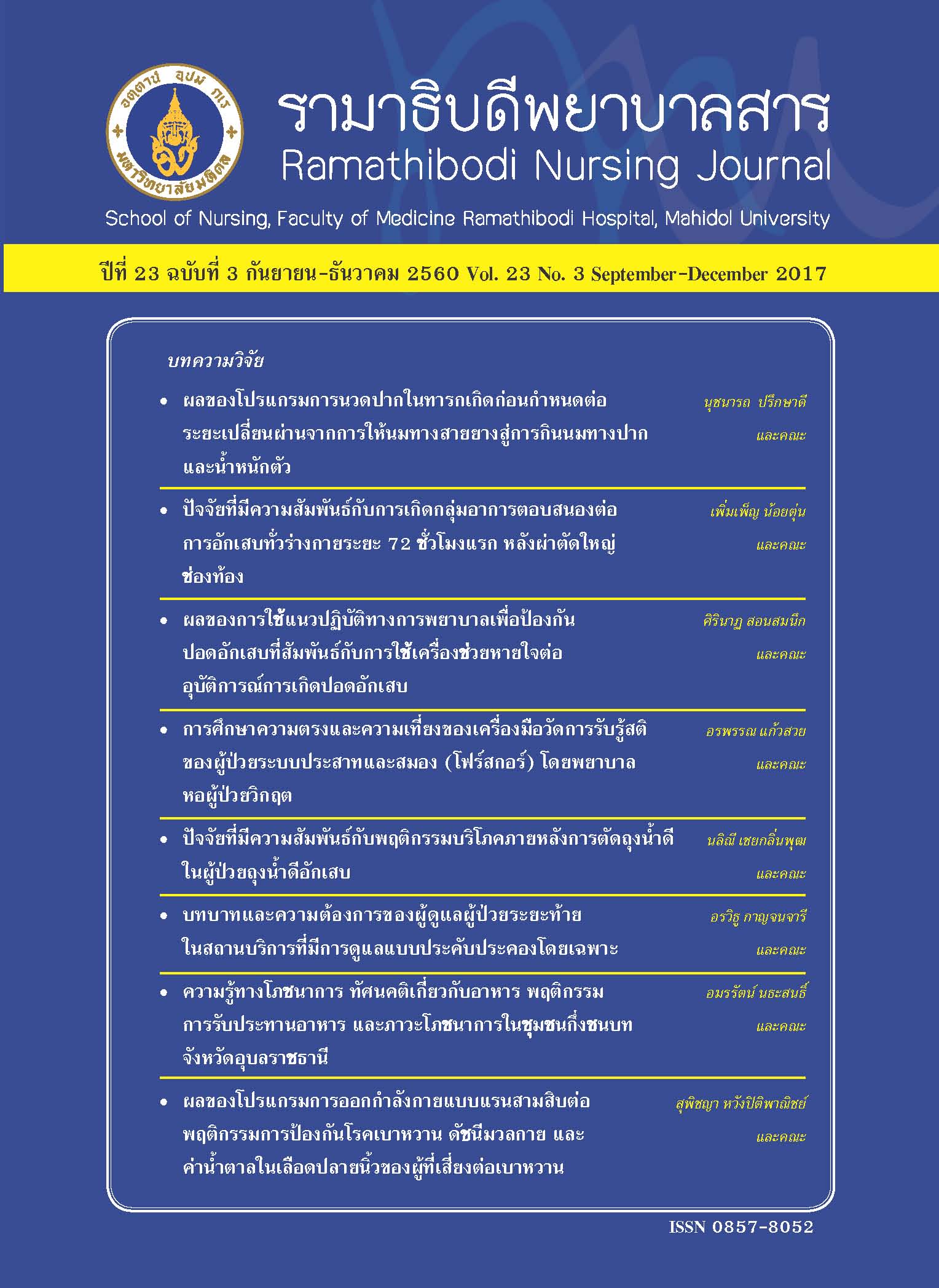Effects of Using Nursing Practice Guidelines for Ventilator Associated Pneumonia Prevention on the Incidence of Ventilator Associated Pheumonia
Main Article Content
Abstract
Abstract:
This study aimed to examine: 1) effects of using nursing practice guidelines for ventilator associated pneumonia (VAP) prevention on the incidence of VAP; 2) nurses’ perception for the importance of nursing practice guidelines for VAP prevention before and after using the guideline; and 3) the adherence of nurses to nursing practice guidelines for VAP prevention. The participatory action research was used as the conceptual framework in this study. The nursing practice guidelines for the prevention of VAP in the surgical intensive care unit comprised the following six parts: 1) mouth care; 2) positioning; 3) enteral feeding; 4) suction secretion; 5) respiratory care and ventilator circuit; and 6) implementation of guidelines for weaning ventilators. Representative samplings were purposive including 32 surgical critical care nurses and 77 patients while receiving mechanical ventilation in the surgical intensive care unit. Data collections were conducted for 4 months. The findings of the study revealed that after using nursing practice guidelines for VAP prevention, the incidence of VAP was decreased from 6.14 to 1.14 times in 1000 ventilator days. The mean score of nurses’ perception for the importance of nursing practice guidelines for VAP prevention were high in both before and after intervention. The mean score of nurses’ adherence to nursing practice guidelines for VAP prevention after intervention was higher than that before the intervention. The findings that reflect implementation of nursing practice guidelines for VAP prevention by using participatory action research could reduce the incidence of VAP.
Keywords : Ventilator associated pneumonia, Perception of importance, Adherence, Participatory action research
Article Details
บทความ ข้อมูล เนื้อหา รูปภาพ ฯลฯ ที่ได้รับการตีพิมพ์ในรามาธิบดีพยาบาลสาร ถือเป็นลิขสิทธิ์ของวารสาร หากบุคคลหรือหน่วยงานใดต้องการนำทั้งหมดหรือส่วนหนึ่งส่วนใดไปเผยแพร่หรือเพื่อกระทำการใด ใด จะต้องได้รับอนุญาตเป็นลายลักษณ์อักษรจากรามาธิบดีพยาบาลสารก่อนเท่านั้น
References
2. Faculty of Medicine Ramathibodi Hospital, Mahidol University, Infection Control Committee. Surveillance database of Ramathibodi Hospital, 2013. Ramathibodi Hospital (Thailand): Mahidol University; 2013. (in Thai)
3. Bansode BR. Ventilator-associated pneumonia (VAP). Medical Update. 2011;415-9.
4. Tao L, Hu B, Rosenthal VD, Zhang Y, Gao X, He L. Impact of a multidimensional approach on ventilator-associated pneumonia rates in a hospital of Shanghai: findings of the International Nosocomial Infection Control Consortium. J Crit Care. 2012;27:440–6.
5. Mathai AS, Phillips A, Kaur P, Isaac R. Incidence attributable costs of ventilator-associated pneumonia (VAP) in a tertiary-level intensive care unit (ICU) in northern India. J Infect Public Health. 2015;8:127-35.
6. Kiyoshi-Teo H, Cabana MD, Froelicher ES, Blegen MA. Adherence to institution-specific ventilator-associated pneumonia prevention guidelines. AJCC. 2014;23(3): 201-14.
7. Kollef MH, Hamilton CW, Ernst FR. Economic impact of ventilator-associated pneumonia in a large matched cohort. Infect Control Hosp Epidemiol. 2012;33(3):250-6.
8. Kandeel N, Tantawy N. Current nursing practice for prevention of ventilator-associated pneumonia in ICUs. Life Sci J. 2012;9(3):966-75.
9. Cheng CH, Lee CF, Soong RS, Wu TH, Chan KM, Chou HS, et al. Risk factors and clinical outcomes of ventilator-associated pneumonia in patients on the liver transplant waiting list. Transplant Proc. 2012;44(3):762-4.
10. Ali NS. Critical care nurses’ knowledge and compliance with ventilator-associated pneumonia bundle at Cairo university hospitals. JEP. 2013;4(15):66-78.
11. Centers for Diseases Control and Prevention. Ventilator-associated pneumonia (VAP) [internet]. 2010 [cited 2014 May 30]. Available from: https://www.cdc.gov/hai/vap/vap.html
12. Tablan OC, Anderson LJ, Besser R, Bridges C, Hajjeh R; CDC; et al. Guidelines for preventing health-care--associated pneumonia, 2003: recommendations of CDC and the Healthcare Infection Control Practices Advisory Committee. MMWR Recomm Rep. 2003:53;1-36.
13. Faculty of Medicine Siriraj Hospital, Bamrasnaradura Infectious Diseases Institute, Department of Diseases Control, Ministry of Public Health. Ventilator-associated pneumonia prevention guidelines [Internet]. [cited 2009]. Available from: http://www.bamras.org/infectioncontrol/pdf/13.pdf.
14. Faculty of Medicine Ramathibodi Hospital; Mahidol University, Infection Control Committee. Surveillance database of Ramathibodi Hospital, 2013. Ramathibodi Hospital (Thailand): Mahidol University; 2014. (in Thai)
15. Bird D, Zambuto A, O’Donnell C, Silva J, Korn C, Burke R, et al. Adherence to ventilator-associated pneumonia in the surgical intensive care unit. Arch Surg. 2010;145(5): 465-70.
16. Sedwick MB, Lance-Smith M, Reeder SJ, Nardi J. Using evidence-based practice to prevent ventilator-associated pneumonia. Crit Care Nurse. 2012;32(4):41-51.
17. Kaynar M, Mathew JJ, Hudlin MM, Gingras DJ, Rits RH, Jackson MR, et al. Attitudes of Respiratory therapists and nurses about measures to prevent ventilator-associated pneumonia: a multicenter, cross sectional survey study.Respir Care. 2007;52(2):1687-94.
18. Browne JA, Evans D, Christmas LA, Rodriguez M. Pursuing excellence development of an oral hygiene protocol for mechanically ventilated patients. Crit Care Nurs Q. 2011; 34(1): 25-30.
19. Faculty of Medicine Ramathibodi Hospital Mahidol University, Intensive care unit ward(5IC). February monthly meeting of Intensive care unit ward(5IC); 2013 Feb 19; Bangkok, TH. Bangkok: Minute of Intensive care unit ward(5IC); 2013. (in Thai)
20. El-khatib MF, Zeineldine S, Ayoub C, Husari A, Bou-Khalil PK. Critical care clinician’ knowledge of evidence-based guidelines for preventing ventilator associated pneumonia. AJCC. 2010;19(3): 272-6.
21. McEvoy L, Duffy, A. Holistic practice- a concept analysis. Nurse Educ Pract. 2008;8(6): 412-9.
22. World Health Organization (WHO). Health topics Patient safety [internet].2014[cited 2014 May]. Available from: http://www.who.int/topics/patient_safety/en/
23. Pattanasan S. The effects of participartory action research on the incidence of ventilator associated pneumonia [thesis]. Nakhon Pathom: Mahidol University; 2010. (in Thai)
24. Kemmis S, McTaggart R. Strategies of Qualitative Inquiry. Geelong, Australia: Deakin University Press; 2007.
25. Unahalekhaka A, Jamulitrat S, Chongsuvivatwong V, Øvretveit J. Using a collaborative to reduce ventilator-associated pneumonia in Thailand. Jt Comm J Qual Patient Saf. 2007;33(7):387-94.
26. Faculty of Medicine Ramathibodi Hospital; Mahidol University, Infection Control Committee. Surveillance database of Ramathibodi Hospital, 2013. Ramathibodi Hospital (Thailand): Mahidol University; 2015. (in Thai)
27. Munro N, Ruggiero M. Ventilator-associated pneumonia bundle: reconstruction for best care. AACN Adv Crit Care. 2014;25(2):163-75.
28. Balamurugan E, Kanimozhi A, Kumari G. Effectiveness of chlorhexidine oral decontamination in reducing the incidence of ventilator associated pneumonia: a meta-analysis. BJMP. 2012;5(1):1-5.
29. Nakonputtana B, Duangmorrakot N. A quality improvement to reduce ventilator associated pneumonia. Bulletin of Nosocomial Infection Control Group of Thailand. 2008;18:23-35. (in Thai)


